Gardens are magical spaces where children can explore, play, and learn about the wonders of nature. However, designing a garden that is safe, engaging, and stimulating for children requires careful planning and consideration. From selecting child-friendly plants to creating play areas that encourage imagination and creativity, numerous strategies can transform any garden into a paradise for young adventurers. In this article, we will explore the top strategies for creating a child-friendly garden that fosters a love for the outdoors and provides endless opportunities for fun and learning.
Safety First
When designing a child-friendly garden, safety should always be the top priority. Start by removing any potential hazards, such as sharp objects, poisonous plants, or thorny bushes. Make sure pathways are clear and free from tripping hazards, and install fences or barriers to prevent access to areas that may pose risks, such as ponds or steep slopes. Choose child-friendly materials for pathways and play areas, such as rubber mulch or soft grass, to cushion falls and reduce the risk of injuries. It’s also important to carefully consider the placement of plants and structures to ensure that children have plenty of space to play without encountering obstacles or dangers.
Engaging Design Elements
To keep children engaged and excited about spending time in the garden, incorporate a variety of design elements that stimulate the senses and encourage exploration. Create different zones within the garden, such as a sensory garden filled with fragrant herbs and flowers, a wildlife area with bird feeders and insect hotels, and a vegetable patch where children can grow their fruits and vegetables. Consider adding interactive elements like wind chimes, water features, or outdoor musical instruments to inspire creativity and curiosity. Additionally, incorporating gardening products that will completely transform your garden can enhance the overall experience for children and adults alike. Include features like stepping stones, tunnels, and secret hideaways to spark imagination and encourage active play.
Child-Friendly Plants
Choosing the right plants is essential for creating a child-friendly garden that is both safe and engaging. Opt for non-toxic plants that are sturdy and easy to care for, such as sunflowers, marigolds, and lavender. Avoid plants with thorns, spines, or berries that may be harmful if ingested, and be mindful of any allergies that children may have. Incorporate a mix of colors, textures, and scents to create a sensory-rich experience, and include plants that attract butterflies, bees, and other pollinators to teach children about the importance of biodiversity. Encourage children to get involved in planting and caring for their own garden beds, fostering a sense of responsibility and connection to the natural world.
Playful Features
Integrating playful features into the garden can transform it into a wonderland of adventure and discovery. Consider installing a sandbox for digging and building, a climbing frame or treehouse for active play, or a mud kitchen where children can unleash their creativity and imagination. Incorporate natural materials like logs, boulders, and tree stumps for climbing, balancing, and exploring, and add elements like rope swings, zip lines, or trampolines for extra excitement. Don’t forget to leave plenty of open space for running, jumping, and playing games like tag or hide-and-seek, allowing children to burn off energy and develop gross motor skills while enjoying the outdoors.
Educational Opportunities
A child-friendly garden provides endless opportunities for learning and discovery. Use labels and signs to identify different plants and wildlife species, and encourage children to observe, record, and research their findings. Create themed garden beds, such as a butterfly garden or a herb garden, to teach children about specific topics like pollination or culinary herbs. Integrate educational activities like scavenger hunts, nature walks, and gardening workshops to engage children in hands-on learning experiences that foster curiosity and critical thinking skills. Use the garden as a living laboratory for exploring scientific concepts like photosynthesis, ecosystems, and the water cycle, making learning fun and interactive.

Maintenance and Sustainability
Maintaining a child-friendly garden requires ongoing care and attention to ensure that it remains safe, healthy, and vibrant. Involve children in age-appropriate gardening tasks like watering, weeding, and harvesting, teaching them valuable life skills and instilling a sense of pride and accomplishment. Use organic gardening practices to minimize exposure to harmful chemicals and pesticides, and compost garden waste to enrich the soil and reduce waste. Consider installing rain barrels or a drip irrigation system to conserve water, and choose drought-tolerant plants that require minimal irrigation once established. Emphasize the importance of environmental stewardship and sustainability, inspiring children to become responsible caretakers of the planet and advocates for positive change.
Creating a child-friendly garden is a rewarding endeavor that offers countless benefits for children and families alike. By prioritizing safety, incorporating engaging design elements, selecting child-friendly plants, integrating playful features, providing educational opportunities, and practicing sustainable maintenance, you can create a magical outdoor space where children can learn, explore, and grow in harmony with nature. Whether you have a sprawling backyard or a small urban plot, there are endless possibilities for creating a garden that inspires imagination, fosters connection, and nurtures a lifelong love of gardening and the great outdoors. So roll up your sleeves, grab a shovel, and start transforming your outdoor space into a haven of fun, learning, and adventure for children of all ages.

